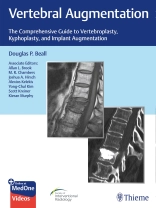The definitive guide to performing vertebroplasty, kyphoplasty, and implant augmentation from national and international experts
Vertebral compression fractures (VCFs) result from trauma or pathologic weakening of the bone and are associated with conditions such as osteoporosis or malignancy. Worldwide, VCFs impact one in three women and one in eight men aged 50 and older, with more than 8.9 million fractures incurred annually. Copublished by Thieme and the Society of Interventional Radiology, Vertebral Augmentation: The Comprehensive Guide to Vertebroplasty, Kyphoplasty, and Implant Augmentation provides a practical, clinical discussion of these minimally invasive spine interventions.
Written and edited by Douglas Beall along with associate editors Allan Brook, M. R. Chambers, Joshua Hirsch, Alexios Kelekis, Yong-Chul Kim, Scott Kreiner, and Kieran Murphy, this richly illustrated book presents a multidisciplinary and international perspective. It features contributions from renowned experts in interventional radiology, neurosurgery, pain medicine, and physiatry. This resource fills a gap in the literature, with extensive updates on a vast amount of new information and techniques that have been introduced during the past decade. Thirty-five chapters address treatment of spine fractures, starting with a history and introduction to vertebral augmentation, discussion of VCFs, patient assessments, physical exam findings, pain management, and much more.
Key Features
- Procedural chapters cover vertebroplasty, sacroplasty, cervical and posterior arch augmentation, balloon kyphoplasty, and vertebral augmentation with implants and for challenging pathologies
- Special topics include radiation exposure and protection, post-procedure physical therapy, osteoporosis treatment, postural fatigue syndrome, the effect on morbidity and mortality, and cementoplasty outside the spine
- Treatment of complex cases are also discussed extensively, including chronic vertebral compression fractures, neoplastic vertebral compression fractures, instrumented spinal fusions, and severe benign and malignant fractures
- The final chapter features 16 subchapters from global masters of vertebral augmentation, with personal tips, tricks, and pearls they use in their own practices
This is a must-have resource for interventional radiology, neurosurgery, interventional pain management, and orthopaedic surgery residents and fellows, as well as seasoned clinicians who wish to incorporate these procedures into practice.
This book includes complimentary access to a digital copy on https://medone.thieme.com.
Jadual kandungan
1 History and Introduction to Vertebral Augmentation
2 Vertebral Compression Fractures
3 Preprocedure Assessment Prior to Vertebral Augmentation
4 Physical Examination Findings in Patients with Vertebral Compression Fractures
5 Medical Pain Management in Patients with Vertebral Compression Fractures
6 Approaches to the Vertebral Body
7 Properties of Bone Cements and Vertebral Fill Materials: Implications for Clinical Use in Image-Guided Therapy and Vertebral Augmentation
8 Vertebroplasty
9 Sacroplasty: Management of Sacral Insufficiency Fractures
10 Cervical and Posterior Arch Augmentation
11 Balloon Kyphoplasty
12 Vertebral Augmentation with Implants
13 Radiation Exposure and Protection: A Conversation Beyond the Inverse Square Law, Thermoluminescent Dosimeters, and Lead Aprons
14 Appropriateness Criteria for Vertebral Augmentation
15 Literature Analysis of Vertebral Augmentation
16 Cost-Effectiveness of Vertebral Augmentation
17 Additional and Adjacent Level Fractures after Vertebral Augmentation
18 Predisposing Factors to Vertebral Fractures
19 Bracing for Spinal Fractures
20 Amount of Cement or Vertebral Fill Material for Optimal Treatment and Pain Relief
21 Clinical Presentation and the Response to Vertebral Augmentation
22 Effect of Vertebral Augmentation on Morbidity and Mortality
23 Number of Levels Appropriately Treated with Vertebral Augmentation
24 Pain after Vertebral Augmentation
25 Postural Fatigue Syndrome
26 Physical Therapy after Vertebral Augmentation
27 Sham vs. Vertebral Augmentation
28 Treatment of Chronic Vertebral Compression Fractures
29 Treatment of Neoplastic Vertebral Compression Fractures
30 Vertebral Augmentation in Instrumented Spinal Fusions
31 Biomechanical Changes after Vertebral Compression Fractures
32 Advanced Principles of Minimally Invasive Vertebral Body Stabilization in Severe Benign and Malignant Fractures: Stent-Screw Assisted Internal Fixation
33 Cementoplasty Outside the Spine
34 Treatment of Osteoporosis after Vertebral Augmentation
35 Miscellaneous Tips by the Masters of Vertebral Augmentation












